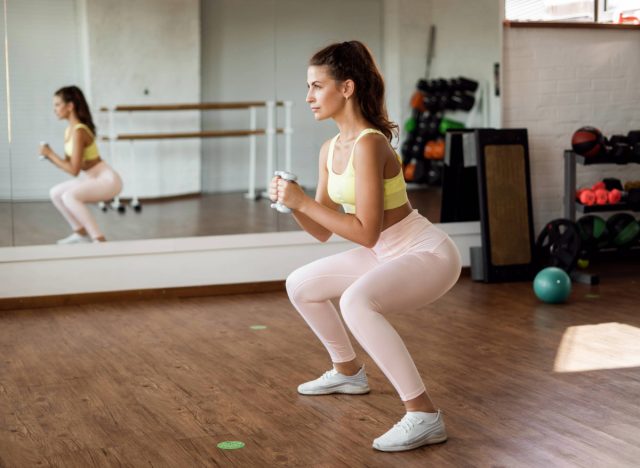When it comes to lifting weights to build muscle, you may be under the impression that you need to “go big or go home.” However, lifting heavier weights isn’t necessarily the key to accelerating muscle growth. From training in the proper rep range to using a weight that still feels challenging, we’re here to share 10 pro tips for building muscle with lighter weights.
Working with lighter weights is the most productive way to boost muscular endurance, explains Domenic Angelino, CPT and author from the International Personal Trainer Academy (NPTA). “Muscular endurance is a measure of how fatigue-resistant your muscles are and how long they can generally hold a contraction or repeat a contraction before getting so tired that they have to rest,” he tells us.
In addition, it’s crucial to note that using lighter weights doesn’t mean choosing a weight that’s too light, as this can derail your progress. “Generally, lighter weight training will involve sets between 10 and 20 reps, but the most effective sets are between 10 and 15 reps in most cases,” Angelino points out. “You should try to use a weight that is a near-maximal effort [to] get the most out of your training when aiming to build muscle. It’s generally helpful to use weights just heavy enough for you to have one to two reps left in the tank at the end of your final set.”
Now that we have that covered, grab your dumbbells, and let’s explore 10 of the best tips for building muscle with lighter weights.
Use a weight that still challenges you.


It’s common to select a weight that’s too light. However, this won’t challenge your body.
“Do your best to make sure the weight is the near-maximal weight you can use for the number of reps you aim for,” Angelino stresses. “Using a weight that is too light for your current level of strength can lead to wasted time in the gym and less overall progress, which can be demotivating.”
Train in the correct rep range.


The weight you lift and the number of reps you do have an inverse relationship. The lighter the weight, the more reps you should perform. Conversely, it’s also possible to overdo it with reps.
“This is because the effect that lifting weights has on your body actually differs depending on the number of reps you do,” explains Angelino. “Ideally, you want to be in the 10 to 15-rep range in most cases when working with lighter weight. The wider range, which includes some of the rarer situations, is 10 to 20 reps.”
If you want to gain more muscle while lifting lighter weights, Angelino says staying in the 10 to 12-rep range will give you the best results.
Use light weight training for the muscles that best respond to it.


Did you know that certain muscles respond best to light weight training, while others benefit more from heavier lifting? This is why Angelino recommends using light weight lifting for the muscles that best respond to it.
“Your calves, for example, respond very well to light weight training,” Angelino explains. “So, if you want to increase the size of your calves, you would benefit from training in as high as the 15 to 20-rep range.”
Perform slower lifts.


Amanda Capritto, a certified personal trainer, sports nutrition coach, and functional training specialist, encourages you to slow things down a bit. “Increase the tempo of the eccentric (lowering) portion of the lift,” she says. “For instance, when squatting, take a full three-count to descend to the bottom rather than quickly dropping into the bottom of a squat.”
Combine equipment.


Whether you’re lifting at home or at the gym, it’s wise to combine equipment to increase the efficiency of your workout.
“If you have resistance bands and dumbbells, you can combine those pieces of equipment to create a greater load, thus a higher intensity,” explains Capritto. “For instance, you can place a looped resistance band around your shoulders and hold your dumbbells for an RDL, thereby substantially increasing the load compared to using one of those items alone.”
Think about the mind-muscle connection.


Make your light weight lifting routine more effective by focusing on the mind-muscle connection. Angelino says it’s easier to do this when working with lighter weights versus heavier ones.
“If you focus on squeezing the muscle you’re trying to train when using light weights, you will make up for some of the disadvantages of light weight training in terms of muscle fiber recruitment,” he explains.
Incorporate unilateral work.


Focus on one side of your body at a time. Doing so puts a greater stimulus on each side of the body rather than training both sides at the same time.
“It also allows you to use limited weight in a more concentrated way,” says Capritto. “For instance, doing split squats instead of regular squats isolates the muscles in one leg at a time. If you only have, say, 25 pounds available to use, then only one leg is responsible for moving that 25 pounds versus splitting the load across both (12.5 pounds per leg, effectively).”
Test out new ranges of motion.


Another pro tip? Put your mobility to the test and recruit more muscle fibers by going deeper into each lift.
“Try to squat deeper, lock out your elbows overhead, [use a] side lunge instead of a forward lunge, etc. There are a lot of ways to ‘shock’ the body, so to speak, in order to elicit a new response with the same weights,” Capritto tells us.
Add some power.


Power elements or explosive movements can help stimulate your muscles. “Instead of only doing deadlifts, for instance, try power cleans,” Capritto suggests. “Instead of doing goblet squats, do jumping goblet squats.”
Spend more time in your end range of motion.


Boost time under tension by spending more time in the end range of motion. This means pausing at the very bottom of your lifts. “For example, count to three [at] the bottom of your squat before standing up. Or, hold your dumbbells at your shoulders for three seconds before pressing up overhead,” Capritto offers.








